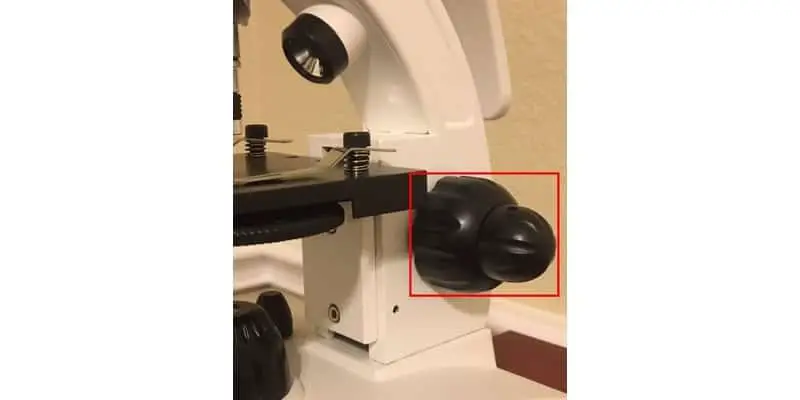If you’ve heard your lab instructor or teacher referring to the “coarse adjustment knobs” or to the “fine adjustment knobs”, you may be wondering ‘what is coarse adjustment and fine adjustment and what’s the difference?’
Coarse adjustment, using the coarse adjustment knobs, raises and lowers the stage more rapidly. Fine adjustment knobs are the smaller knobs and are also used to raise and lower the stage but more slowly and in a more controlled manner under higher magnifications.
In this article we will discuss when it is appropriate to use each, and where they are located on the microscope.
Where are the Coarse Adjustment and Fine Adjustment Knobs?
The coarse adjustment knob on most microscopes is along the lower middle part of the arm of the microscope as shown in the image below.
The coarse adjustment knob is the bigger of the two knobs and is located closest to the arm of the microscope. The fine adjustment knob is the smaller of the smaller of the two knobs and is located further away from the arm of the microscope.
Most coarse and fine adjustment knobs are built with coaxial control in line with one another so you can easily switch from using the coarse focus adjustment knob to using the fine focus adjustment knob. As a side note I have really enjoyed this microscope as a starter microscope to get interested in microscopes and microscopy, so if you are interested in getting this same microscope you can snag it here on Amazon.
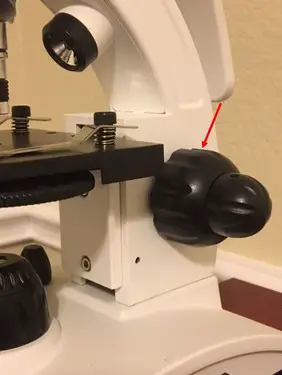
This design was patented by Leonard A. Wilkinson in 1962. Prior to this coaxial design, the two knobs were distinct knobs and you would need to look for them.
Some microscope will still have the two distinct knobs with the smaller being the fine adjustment knob and the larger, the coarse adjustment knob as shown in the image.
The coaxial knob allows the user to change between the knobs by feel instead of having to pull away from the eyepiece to look for the desired knob.
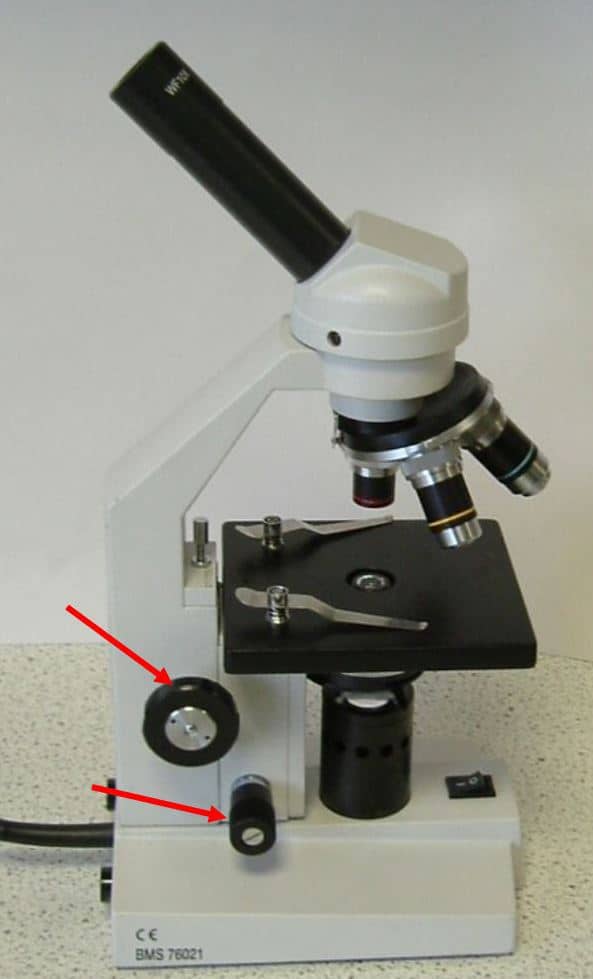
You will notice that when you turn the knob it moves the stage (or the body tube depending on the type of microscope you have) much faster than the fine focus knob (the smaller one).
The fine adjustment knob will be the smaller of the two knobs and when you turn the knob you will notice that the movement is much slower and more controlled. With some fine adjustment knobs, you will hear a slight clicking noise. This is a auditory indicator to give the microscope observer an auditory indicator relative to the act of turning the knob.
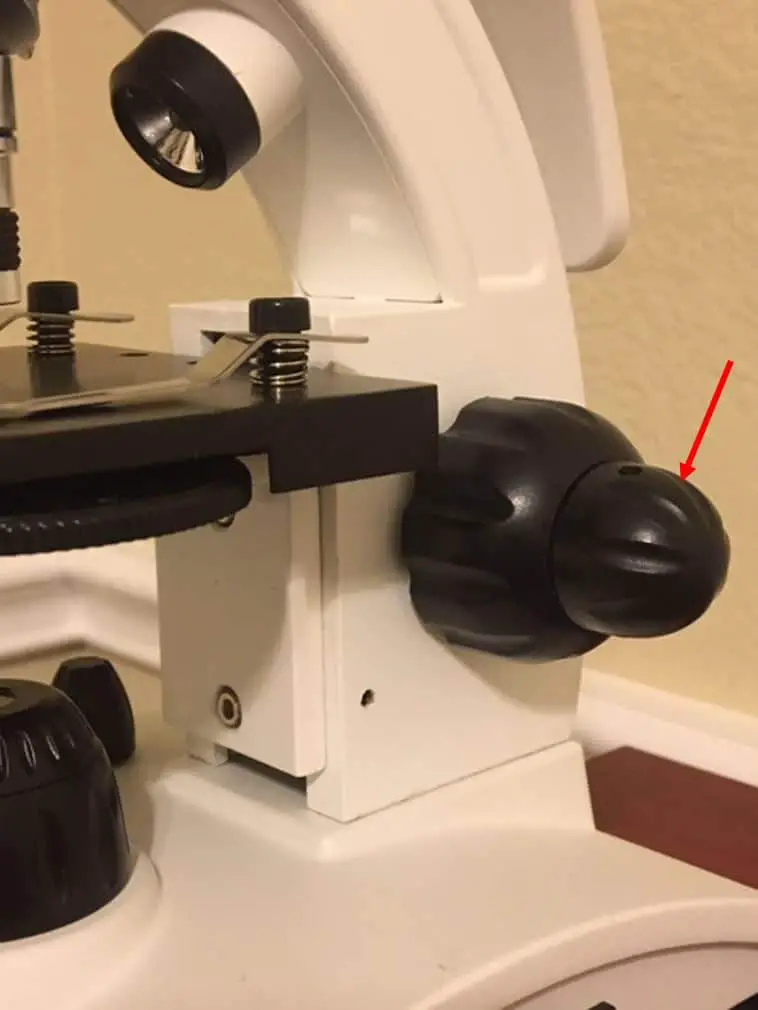
Some coarse and fine adjustment knobs will come with a numeric dial that helps the user with precise adjustment settings like the one shown below. These are typically only on more advanced compound microscopes.
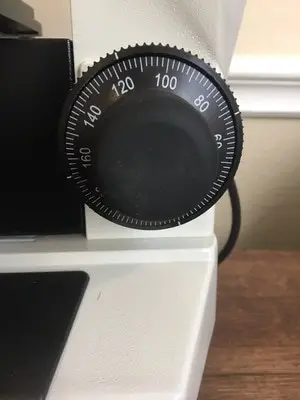
Which One Should I Use
The basics of using a microscope tells us that we should start with the lowest power objective first and with the stage at its lowest position. So if you have just loaded a new specimen and slide you need to make sure you have the lowest power objective engaged and the stage at its lowest position and use the coarse adjustment knob first to quickly get the specimen in focus.
Once you get the specimen in focus you can make positional adjustments to the slide using the mechanical stage X – Y translational knobs or position the slide manually using your fingers.
After you have the slide positioned and centered on your area of study or inquiry you need to engage the next higher power objective lens. This time you will use the fine adjustment knob slowly to focus you image under the higher power objective. Once you find focus the process repeats with the fine focus adjustment knob on the next higher power objectives.
Which Way Do I Turn the Knob?
If your eyepiece(s) on your microscope is built facing away from the arm of the microscope then turning the knob away from you will raise the stage and turning the knob towards you will lower the stage. If you are looking at it from the side turning the knob clockwise will raise the stage and turning the microscope counterclockwise will lower the stage.
How to Adjust Tension
Some microscopes will come with a tension adjuster. This allows you to manipulate the tension of the adjustment knob to determine how soft or how hard do you have to turn the knob to attain the desired level of movement from each revolution of the knob.
Some microscopes that have this feature will come with a tool that can be used to do this and others do not require a tool. This feature allows personalize the tension to a level that feel comfortable to each user of the microscope.
This video illustrates how to adjust the tension on various types of microscopes.
Takeaways
Knowing the difference between fine adjustment and coarse adjustment knobs on the microscope is an integral part of focusing the microscope.
The coarse adjustment knob quickly gets the image in focus and the fine adjustment knobs help keep the image in focus under progressively higher magnifications.
I hope this article was helpful and will either help you ace the lab quiz or have more confidence using your microscope.
References
- https://learning.hccs.edu/faculty/m.bracamonte/biol-2401/AP%201%20Course%20Material/ap-1-lab-handouts/microscope-1/parts-of-the-compound-microscope
- https://www.austincc.edu/mlt/clin1/Microscope%20training%202017.docx#:~:text=Coarse%20adjustment%20knob%3A%20This%20knob,the%20objective%20lens%20without%20touching.

